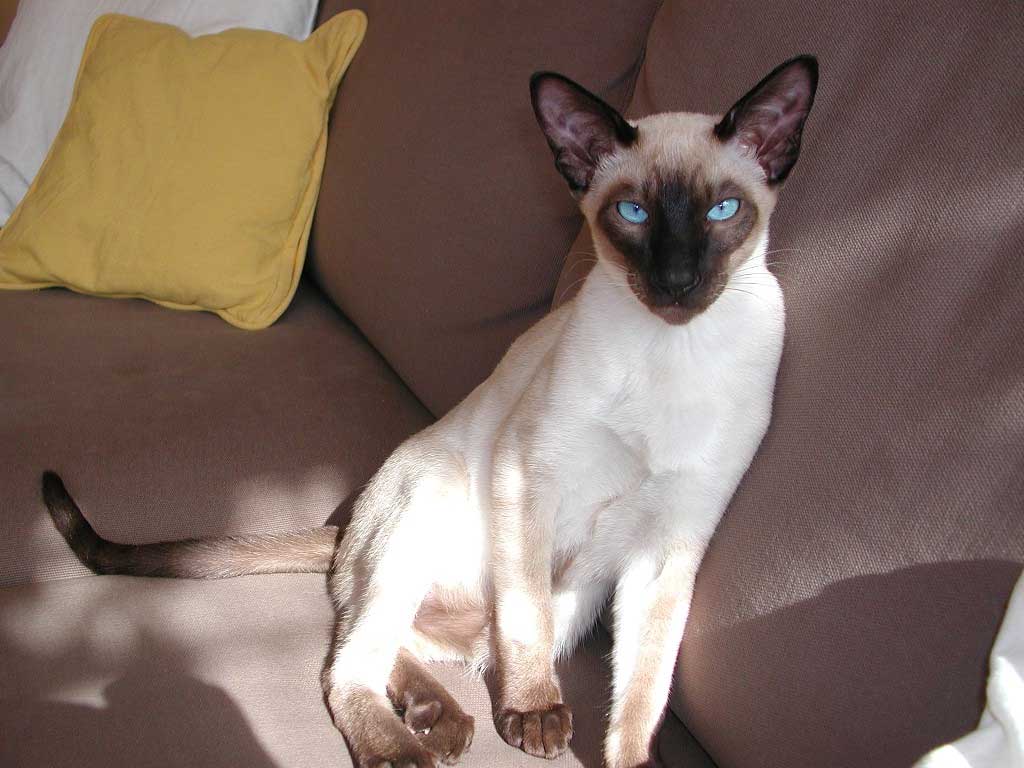
Content |
|---|
Characteristics "Modern Siamese cat"
Coexistence is important that you have with your new friend. Before considering the acquisition of a cat of the breed "Modern Siamese cat" you know certain factors. You must take into account their character, their need for exercise, their interaction with other pets, their care and if you have small children, their level of tolerance towards them.
Joy4.0 out of 5 stars (based on 1 review)
|
Activity level5.0 out of 5 stars (based on 1 review)
|
Friendliness to other pets4.0 out of 5 stars (based on 1 review)
|
|---|---|---|
Friendliness to children4.0 out of 5 stars (based on 1 review)
|
Grooming requirements2.0 out of 5 stars (based on 1 review)
|
Vocality5.0 out of 5 stars (based on 1 review)
|
Need for attention4.0 out of 5 stars (based on 1 review)
|
Affection towards its owners5.0 out of 5 stars (based on 1 review)
|
Docility5.0 out of 5 stars (based on 1 review)
|
Intelligence5.0 out of 5 stars (based on 1 review)
|
Independence2.0 out of 5 stars (based on 1 review)
|
Hardiness3.0 out of 5 stars (based on 1 review)
|
History
The sophisticated Siamese takes its name from its country of origin, the kingdom of siam, which is now thailand. The oldest document that mentions it, the Tamra Maew, data of 1350 and was found in Ayutthaya, the capital of the kingdom since 1350 until 1767. This work is a treatise on cats, in the form of poems accompanied by illustrations. Some of the illustrations show cats with thin, pale bodies and darker masks on their faces., ears, legs and tails. At that time, they were cross-eyed and had knots in their tails, characteristics that only centuries later became defects that breeders were able to practically eliminate.
Legend has it that these cats were none other than the guardians of royal treasures, and that they watched them with such attention that they ended up squinting.
In Europe, it was in great britain, at the end of the 19th century, where the Siamese was first heard. In 1871, two specimens were exhibited in the first feline exhibition in modern history, held in the Crystal Palace From london. In the event catalog it was said that they were the first to set foot in the country, which is very likely.
But, they were not the ones who started the development of the breed in the country, but Pho and Mia, two specimens that Owen Gould, British Consul General, received in 1884 as a gift from the king of Siam.
He took them to Britain and his sister, Lilian Jane Veley, took care of them. He fell in love with these magnificent cats and decided to present them at the Palacio de Cristal Exhibition in 1885. Aroused great interest from the public. There are some photographs from this time that show that they were quite robust and had a round head.. They were the first two specimens registered in the British Register of Siamese, a register kept by one of the cat owners' clubs which had been in existence for several years and which were the forerunners of the Governing Council of the Cat Fancy (GCCF), founded in 1910.
They died right after this exposure, but meanwhile they had given birth to a litter. Lilian Jane Veley continued to dedicate herself to these cats; with a view to developing the breed, came to found the Siamese Cat Club in 1901, the world's first Siamese breed club.
Among 1884 and late nineteenth century, many were imported siamese cats from Siam to Great Britain and enrolled in the British Siamese Register. In fact, the breed quickly gained in popularity among the English aristocracy; as a result of fashion, many of its members wanted to own one. In 1892 a standard was developed that defined the physical attributes that a subject must have to be admitted to the registry.
The Siamese arrived in France in 1885, when a French diplomat brought two specimens from Bangkok to the Jardin des Plantes in Paris. In 1893, the Dr. Oustalet, professor at the Museum of Natural History, wrote about the siamese cats brought by the president's daughter-in-law Carnot. He took care to describe them accurately and wondered if this race descended from a wild species..
The introduction of Siamese cat in the United States took place in 1879. The American Consul in Bangkok, after learning about the fondness for cats of the then president's wife, Rutherford Birchard Hayes, sent him a Siamese, who he called Siam.
The breed really took off in America in the early 1900s, helped by the lady's cats Clinton Locke. Founder in 1899 of the Beresford Cat Club, the first registry of breed cats in the country, bought a copy in France, Lockehaven Siam, which won the award for the best cat in America in 1906 en Detroit. He repeated this feat the following year in Chicago, this time with a female, Lockehaven Elsa. In 1909 a breed club was founded, the Siamese Cat Society of America, who published a first standard.
But, the breed's development was interrupted by the First World War, both in the United States and in Europe.
The development of Siamese cat in the United States it also owes a lot to Virginia Cobb. Originaria de Massachusetts, fell in love with the breed during a cat show at the Madison Square Garden of New York in 1928. He decided to import his first copy, whom he called CH Oriental Nanki Pooh de Newton. This female lived 17 years and had many litters.
In addition to being very active and involved in the breeding and distribution of Siamese in United States, Virginia Cobb was also interested in its genetics. In collaboration with Clyde Edgar Keeler, Harvard University geneticist, explored in particular the scientific aspects of different coat colors. The first known color of the Siamese had been the seal point, with dark brown tips and a creamy coat. But, as reproductions were made, appeared the blue point (dark blue tips and bluish-white fur), the chocolat point (chocolate tips, ivory fur) and the lila point (pink gray tips, White fur).
The Second World War was a second brake on the expansion of the race, especially in Europe. At the end of the war, the breed was even on the verge of extinction in Britain.
New blood was needed to expand the gene pool and advance. Once again, several specimens were imported from Thailand, both to Europe and the United States.
But, just like before the two world wars, the Siamese had difficulty adapting to the local climate, very different from the tropical climate of your native Thailand. Breeders in all countries faced heavy losses, mostly due to gastroenteritis and parasites.
This did not prevent the breed from gaining popularity from the decade of 1960, both in Europe and the United States. Many breeders and show judges began to favor a slimmer look. The latter began to gradually evolve, as breeding and selection progressed.
The Americans, in particular, they preferred a tubular and elegant body, as well as a long head. Englishmen, on the other hand, they gave priority to almond eyes, large ears and a little lower on the skull. In addition to evolving, standards also began to differ from country to country.
But, around the world, the Siamese got longer, with a fine bone structure and a narrow head. The breeders' work also made it possible to eliminate strabismus and tail knots..
This way of evolving the morphology of the breed was chosen by most breeders, since the beginning of the years 70. Other, few, they decided to keep Thai cat. With the passing of the decades, the gap between a Modern Siamese cat, heavily modeled by man, and Thai cat, corresponding to the original physical type of the breed and known as Thai. At the beginning of the Decade of 2000, the latter was finally recognized as a distinct breed by most official bodies.
But, the Modern Siamese cat has stolen much of the limelight and enjoys much greater popularity. This explains that she herself was at the origin of several other races:
- the Balinese cat, who is none other than a modern long-haired Siamese;
- the Oriental shorthair cat, result of crossing the Siamese with the Russian Blue Cat, the British Shorthair cat and the Abyssinian cat;
- the Himalayan cat, produced by crossing the Siamese and the Persian cat;
- the Tonkinese cat, a cross between Siamese and the Sacred Cat of Burma (Birman);
- the Oriental Longhair cat, a cross between Balinese cat and the Oriental shorthair cat;
- the Ocicat cat, created from Siamese and the Abyssinian cat.
The recognition of Modern Siamese cat

With a history of several centuries, the Modern Siamese cat began to be recognized by national and international official organizations in the years 30.
The American Cat Breeders Association (CFA) was the first to recognize the breed in 1934. The Governing Council of the Cat Fancy (GCCF) did the same in 1936.
The Fédération Internationale Féline (FIFé), that brings together the feline authorities of some forty countries, including Switzerland and Belgium, did the same in 1949. Ten years later, also recognized the Oriental shorthair cat, before doing the same in 1983 with the him Balinese cat, and then in 1985 with the him Oriental Longhair cat: these four races together constitute a group in their own right.
The Canadian Cat Association (CCA) recognized the Siamese in 1950, just one year after FIFé.
In 1979, the International Cat Association (TICA) also recognized the Siamese and included him in a group with the Balinese cat, the Oriental shorthair cat and the Oriental Longhair cat, who were admitted at the same time.
Popularity of "Modern Siamese cat"
In Europe, It was in Great Britain that the Siamese, and still today it is in this country where he is most successful. Still the most successful cat in the UK, ranking fourth in number of annual registrations in the British Governing Council of the Cat Fancy (GCCF), at around 1.500 a year. But, this figure triples that of the middle of the years 90, when the number of records exceeded 4.500 a year and was the second highest. The decline was especially marked in the second half of the 1990s. 2000, but continued throughout the next: early in the decade 2010 there was still more than 2.000 registrations per year.
In France, there has also been a decrease in both absolute and relative terms, and in any case the breed has never reached similar popularity levels. Nails on 250 registrations per year in the Livre Officiel des Origines Félines (LOOF), the breed is located around the position 20. In the middle of the Decade of 2000, this figure was rather 350 births per year.
In Switzerland, the Siamese has also lost part of its glory. After a peak of about 150 over the years 90, the number of annual registrations in the Fédération Féline Helvétique (FFH) steadily decreased, to the point that today it does not exceed 50 births per year. But, this places it around the tenth position in the statistics of the organization.
in Canada, it's even more discreet. In fact, the number of kittens registered each year with the Canadian Cat Association (CCA) places it around the position 25 of the ranking.
In United States, the Siamese was between 10 most popular breeds in the country in the early 1990s 2010, According to the annual registration statistics of the Cat Fanciers’ Association (CFA). Since then it has lost ground and is now around the position 12.
Physical characteristics
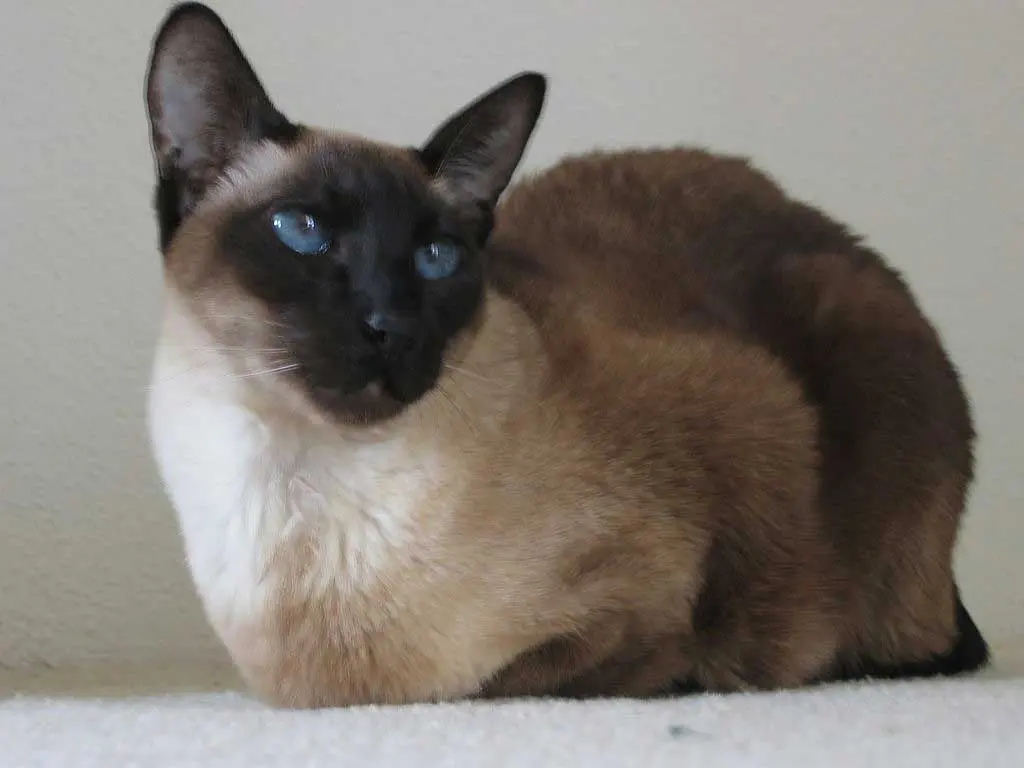
Written in 1892, shortly after the breed's arrival in the West, the first standard of the Siamese lets us know what this cat looks like before breeders got involved. The Siamese he had a stocky body, a head round and eyes blue. It also, many of the cats were cross-eyed and/or had knots in the tail, what was not considered a defect at that time.
The traditional siamese has stayed quite true to this initial appearance, with its body and head round. On the other hand, decades of selective breeding have made the Modern Siamese cat away from the morphology of its ancestor and show more extreme forms: a body delgado, long and tubular, a head long in the shape of a triangle, ears very big and a tail very long and thin.
So, it is quite legitimate that these two cats are considered today as two different breeds, Although they share their intense blue eyes. The work of the breeders has also made it possible to eliminate the problem of strabismus that affected both, as well as the crooked tail.
The appearance of “Modern Siamese cat”
The Modern siamese it is a medium size cat, lanky (Eastern) and elegant looking. Slim and athletic, they have a very harmonious overall look. But, he is quite muscular, which explains why it is heavier than one might think at first glance.
Its long body has a tubular shape, with shoulders and hips of equal width. Has firm musculature and fine bone structure. The tail it is long and fine and ends in a point.
The legs they are well muscled, long, slim and graceful. Hind legs are slightly longer than front legs. Both end in small, oval feet.
The head it is medium size, long, triangular, wedge-shaped and rests on a neck long and thin. The skull and the forehead are flat or very slightly rounded. More concretely, three types of profiles are accepted: straight, slightly convex or in two planes (the plane of the forehead is prolonged with that of the nose, but without a clear break between the two).
The ears they are very big, wide at the base and prolong the triangular shape of the head.
The eyes they are moderately large, macaroons, far apart and deep blue. They can be vairones (one green eye and one blue) in individuals whose fur is particular. Some individuals have both green eyes, but they are not recognized by the norms established by the different official organisms.
The cheeks are flat and dewlap is only allowed in adult males.
The nose it's long and straight, fitting perfectly into the triangle of the face. Its tip should not be narrow. Master medium-sized jaws and a strong chin.
The fur of the Siamese it's closed, shiny and silky. Consists only of an outer coat: this cat doesn't have undercoat. It also, It colourpoint, which means you have a darker mask on your face and ears, as well as on the legs and tail. This makes it look like he's ready to go to a costume party.
The rest of the body color is uniform, with a clear contrast between the body and the extremities, except for kittens. Kittens are born with slightly colored tips, that darken in the following weeks.
The most common combination is seal point: the tips are dark brown and the rest of the body is cream colored. The blue point it is also quite common, with a bluish-white fur and dark blue tips.
Most official agencies accept all color points. It is the case of the Fédération Internationale Féline (FIFé), the International Cat Association (TICA), the Governing Council of the Cat Fancy (GCCF) en el Reino Unido, the Association Féline Canadienne (AFC) or the Livre Officiel des Origines Félines (LOOF) in France.
- The seal point: cream to fawn coat, seal points (dark brown), dark brown pads;
- The chocolat point : ivory cloak, chocolate dots, pink pads and skin of the nose;
- The blue point: bluish white cloak, dark blue tips, slate-colored nose pads and skin;
- The lila point: White fur, lilac tips (grey pink), pink and leather nose pads.
Selective albinism in the Siamese
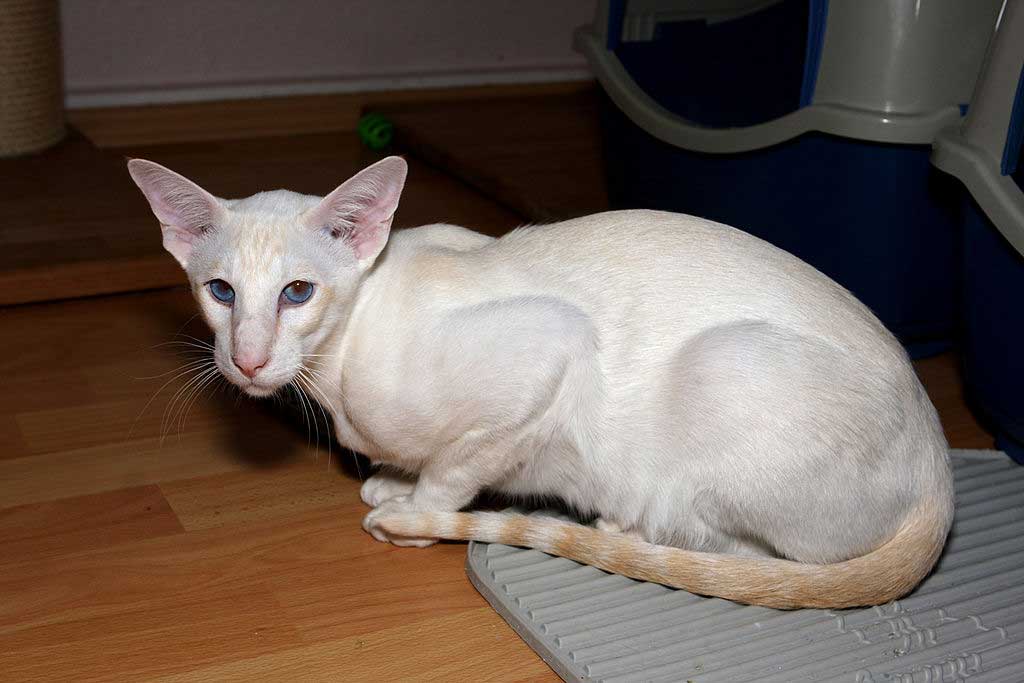
Although the morphology of the Modern Siamese cat has been partially modified by breeders, still basically a natural breed, that was not created by man. In particular, his dark mask on his face, the ears, legs and tail is due to a spontaneous and fairly benign genetic abnormality. This specificity was already visible in the first representations of this cat, dating back several centuries, and it was also found in all individuals imported in the 19th century to Europe and the United States. It is also present in the Thai cat.
It is related to the fact that all Siamese they have the albino gene. This gene encodes a heat-sensitive enzyme, that is to say, is active at low temperatures, but inactive at high temperatures. This explains that the main part of the body, the warmest, be light in color, while the coldest extremities, like ears, the face, legs and tail, They are darker.
The environment affects this thermosensitivity. When the kittens are born, they have a completely light color because the temperature in the uterus is constant and elevated. Their limbs begin to darken within a few weeks, and show their final color when they are about a year old.
This genetic trait also explains why individuals living in warmer climate countries tend to be lighter than those living in colder regions.. This phenomenon also occurs in other breeds colourpoint, as the Balinese cat or the Himalayan cat.
Size and weight
- Male size: 30 cm.
- female size: 30 cm.
- Male weight: 2-6 kg
- female weight: 2-6 kg
Breed standard
The breed standards are documents established by official bodies that list the conditions that a dog must meet. Modern Siamese cat to be fully recognized as belonging to the race:
- Standard FIFé (Fédération Internationale Féline)
- Standard LOOF (Livre Officiel des Origines Félines)
- Standard AFC (Association Féline Canadienne)
- Standard TICA (The International Cat Association)
- Standard CFA (The Cat Fanciers’ Association)
- Standard GCCF (The Governing Council of the Cat Fancy)
Varieties "Modern Siamese cat"
"Modern Siamese cat" |
||
|---|---|---|
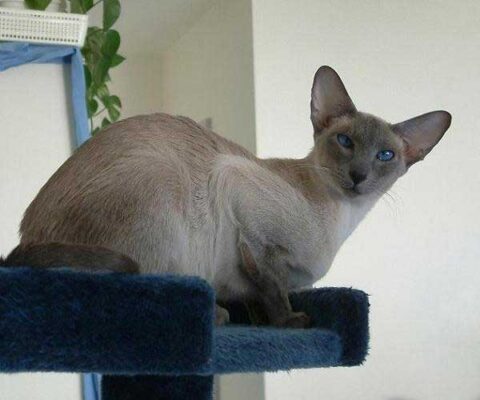 | ||
Although not all of them are necessarily recognized by all feline organizations, or are sometimes considered as simple varieties, the Siamese was the origin of several other races, developed from the years 50:
- The Balinese cat, which is simply a Siamese longhair;
- The Oriental cat, result of crossing the Siamese with the Russian Blue Cat, the British Shorthair cat and the Abyssinian cat;
- The Himalayan cat, created by crossing the Siamese and the Persian;
- The Tonkinese cat, result of marriage between Siamese and the Sacred Cat of Burma (Birman);
- The Oriental Longhair cat, obtained from Balinese cat and of the Oriental shorthair cat;
- The Ocicat cat, created from Siamese and the Abyssinian cat.
But, Things have changed since then, since some organizations now prohibit the breeding of a Siamese with a representative of another race. This is the position of the Cat Fanciers’ Association (CFA) and the Canadian Cat Association (CCA).
On the other hand, other associations authorize marriages with some other races of the same group, in order to expand the gene pool.
Like this, the Fédération Internationale Féline (FIFé), as well as the International Cat Association (TICA), accept matings with :
In France, the Official Book of Feline Origins (LOOF) authorizes people with :
Last, the Governing Council of the Cat Fancy (GCCF) authorizes the mating of the Siamese with :
Character and skills
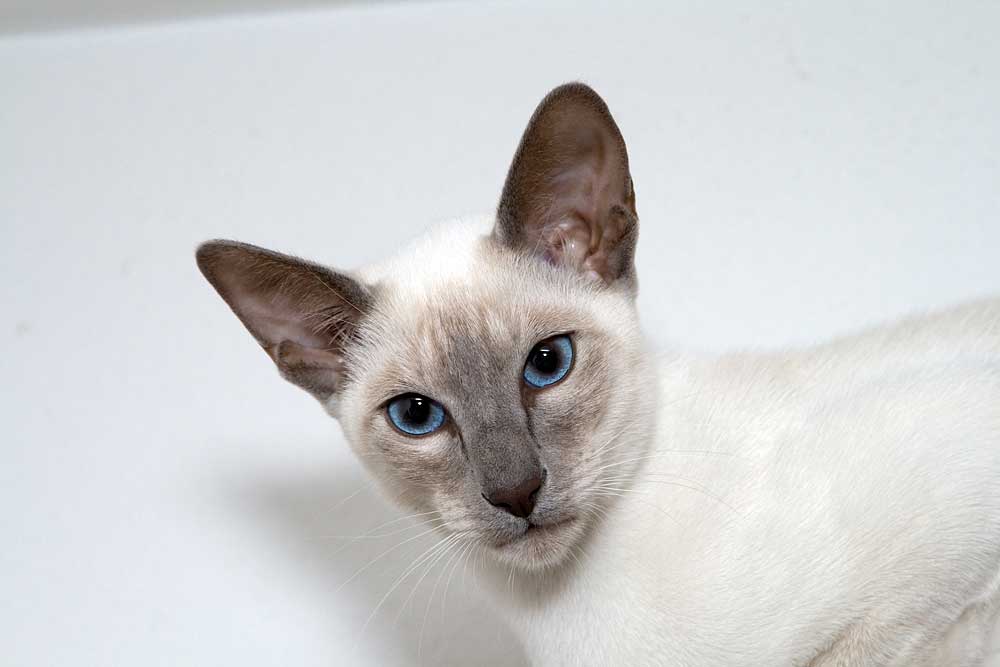
Although their appearance differs, the Modern Siamese cat has a character very similar to Thai cat, although the latter is sometimes presented as a little more sociable.
It is a very affectionate cat, who loves to live as a family. But, it is better if the owner likes cats with a strong character. In effect, he is passionate about the person he considers his human of reference, and establish a very strong relationship with him. He is fully involved in the life of his protector, follows him in all his movements, sleep next to him, leans on his knees in quiet moments… He is totally devoted and faithful to him. So, he is quite a demanding cat: to be fully happy, the Modern Siamese cat needs a master willing to dedicate time, interest, honey and, sometimes, patience.
The downside is that they quickly become possessive and protest if they don't get the attention they expect.. He is very sure of himself, even moody and impatient: you like your requests to be answered quickly, and if you don't get the answer you want, does not hesitate to express his point of view with meows that only cease when he gets his way.
Although it is clear that he has his favorite human, the Modern Siamese cat usually have a good relationship with other people in the family, especially if they surround you with their presence, they caress him and play with him. This is because they help meet your need for care.. But, It may happen that you feel a certain dislike for one of the members of the house and do not hesitate to show it, dismissively ignoring him and refusing to interact with him.
He gets along very well with children and is a very good playmate for them (and vice versa), as long as they treat you with respect. But, remember that a small child should never be left alone with a cat without adult supervision. This is valid regardless of the breed of the cat, for the safety of both parties.
Affectionate with his family, this cat is on the other hand very suspicious of strangers. If a stranger walks in “their” House, prefers to stand aside and observe the situation from above, for example from the top of your cat tree, an essential accessory.
On the other hand, his proximity to family means that he does not appreciate loneliness at all. Not recommended for people who are out most of the day.
In addition to leaving toys to distract him, a solution to make the absences of their masters more bearable may be to make them share their home with a fellow man. In fact, cohabits easily with another cat and is glad to have an additional playmate and partner in crime. This also prevents you from finding other things to do, how to shred paper towels, what he does with some relish.
It is also usually a cat that gets along well with dogs, although this, of course, it also depends on the compatibility of your partner with the feline species. In any case, things go better if coexistence is instituted from an early age. Otherwise, it is better to ensure that the contact is made gradually.
It is much riskier to have a bird or a small rodent living next to you, since his hunting instinct can be awakened at any time. If the situation presents itself, some vigilance is required. These may include, if you are out, the small animal should be kept in a place inaccessible to the cat.
Athletic and energetic, the Modern Siamese cat need to be active. It is imperative that I can run, but this does not necessarily mean that living in a flat is impossible for him, as long as the house is big enough. Especially since it is very possible to teach him to walk on a leash; you are likely to enjoy those outings, since he shares them with his master. But, Ideally, a cat flap would allow you to leave the house whenever you wanted..
In any case, you have to satisfy your urgent need to scratch. If there is no scratching post in the house or garden, will not hesitate to use the furniture or curtains.
Games are essential for him too, both to exercise and to develop or maintain your skills. Playing is essential for your mental and emotional balance and, Therefore, for your well-being.
This is especially true for intelligent and curious children., as it provides them with intellectual stimulation. These traits make him an ideal candidate for anyone who wants to teach their cat tricks., such as retrieve a thrown object. Having said that, does not stop learning various things on his own. Capable of opening taps and doors, they like to hide in cupboards and closets and stay there even when called, until they decide it's time to make their presence felt.
Last, the Modern Siamese cat is known to be a very talkative cat. As they seldom stray far from their owners, who does not like to have a partner who vocalizes all day with a hoarse voice, another breed would be better. It is impossible to avoid this behavior: it is his way of communicating not only with his master, but also with all family members. It is his way of communicating not only with his master, but also with all family members, so you can expect long conversations in which he expresses his approval or disagreement. Si and Am, the talkative conjoined twins of Beauty and the tramp (1955), are perfect examples of the eloquence of this cat.
They can also be very noisy when it comes to claiming attention., especially if they are left for many hours without company or without a toy: no wonder they do a series of shenanigans and long meowing sessions.
Health
"Modern Siamese cat" |
||
|---|---|---|
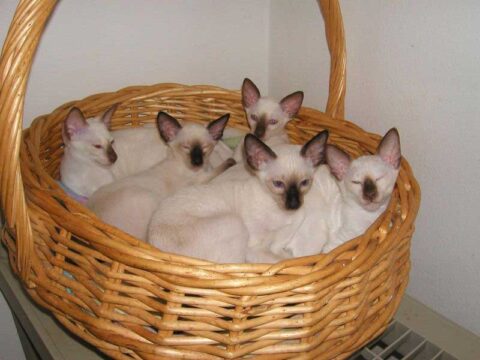 | ||
The Modern Siamese cat it is generally a robust dog.
But, like all races, are more prone to certain ailments. In your case, is about:
- Amyloidosis, a hereditary disease caused by the deposit in different organs of a protein called amyloid, that prevents them from working properly. Most of the time, the kidneys are the most affected, resulting in kidney failure or even diabetes. The main symptoms, if any, are intense thirst and frequent urge to urinate, diarrhea, loss of appetite … Drug treatment and changes in the animal's diet (especially to reduce protein intake) they can wipe out these deposits. But, existing lesions are irreversible;
- Aortic stenosis, a congenital disease that corresponds to a decrease in the diameter of the outlet of the left ventricle of the heart, at the level of the aorta. Most often causes a state of fatigue and a heart murmur. There are treatments to improve the comfort of life of the animal, but the disease itself is incurable;
- Urolitiasis, characterized by stone formation in the bladder, the kidneys or even the ureter. Then, the cat has difficulty urinating, drink more and, sometimes, we notice the presence of blood in the urine. Stones can be removed with surgery;
- Asthma, also known as chronic or allergic bronchitis, causing short-term breathing difficulties and long-term lung damage. Corresponds to an allergic reaction to certain substances present in the environment, like dust mites, pollens, chemical or synthetic products (for example cleaning products), cigarette smoke … The affected animal suffers bouts of coughing and shortness of breath, while your breath makes a kind of hiss. But, treatments can greatly improve your quality of life, reducing both the number and intensity of attacks;
- Respiratory problems, due to the elongated and triangular shape of its head. If so, is less inclined to move and strain;
- Progressive retinal atrophy, an incurable inherited disease that causes progressive deterioration of the cat's eyesight, up to total blindness. Often not detected until very late, when it is very advanced and the cat collides with everything;
- Glaucoma, which is caused by increased pressure in the eye. This gradually degrades the optic nerve, so the affected animal gradually loses sight. Eye drop treatments are sometimes enough to remedy the problem, but the most serious cases require surgery;
- Hereditary strabismus, reducing visual acuity and field of vision. This anomaly manifests itself from birth and is incurable., but not very disabling;
- Mouth problems, again because of the shape of her face.
As many of the conditions the breed is prone to are inherited, it is important to go to a breeder of Siamese serious to obtain an animal that has not only grown up in a quality environment and has benefited from good socialization from its first weeks, but also have all the possibilities to enjoy -and stay- Of good health. In effect, a professional worthy of the name ensures that certain genetic tests are performed on proposed stallions, to make sure they are not carrying a disease that they would risk passing on to their young. If they do it, are excluded from the breeding program. So, must be able to present the results of these tests, along with a certificate of good health from a veterinarian and a list of vaccinations already administered to the kitten, registered in the kitten's health or vaccination card.
Once the adoption is complete, the new owner is responsible for the kitten's health for the rest of its life. A visit to the vet at least once a year, and more often as the cat ages, is essential to maximize the chances of keeping you healthy. This appointment allows the professional to carry out the necessary vaccination boosters, but also, and above all, carry out a complete health check of the animal. The latter should make it possible to detect any health problem as soon as possible., to be able to treat it in the best possible conditions.
At the same time, It is essential to protect your cat against parasites by renewing its antiparasitic treatments throughout the year, whenever necessary, so you never stop being protected. This applies even to an animal that lives in a flat, since you are not completely safe from danger.
Life expectancy
11 to 15 years
Care and grooming
"Modern Siamese cat" |
||
|---|---|---|
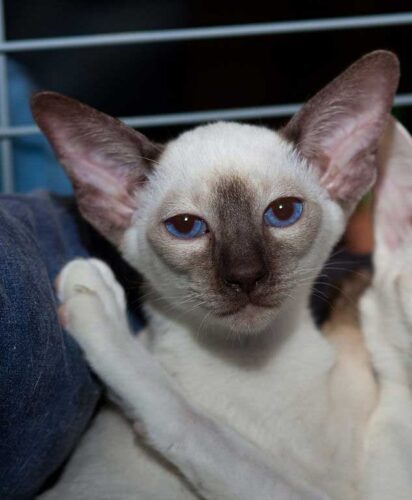 | ||
As beautiful as it is, the fur of the Modern Siamese cat, requires little maintenance, especially because it does not have undercoat. Normally, brushing once a week is enough to remove dead hair and shine the coat.
But, it is better to double the frequency during your annual molts, in spring and autumn. Although the coat is short, the molt is much more pronounced.
The weekly brushing session is also an opportunity to check his ears. Wiping with a damp cloth removes dirt and reduces the risk of infection (for example, in the ears).
You should also check your eyes once a week and, if required, clean them with a damp cloth to prevent dirt from accumulating and becoming infected.
Teeth require more frequent care. It is important to limit the accumulation of plaque, that can cause not only bad breath, but also various diseases of varying severity. Brushing your cat's teeth once a week with a special feline toothpaste is the bare minimum., but it is best to brush more often, or even daily.
Last, it is important to keep your claws in good condition so that they are not too long, which could cause discomfort or even break and hurt you. Whether you live exclusively indoors or have access to the outdoors, should be checked once a month: if natural wear and tear is not enough, must be trimmed manually. This does not prevent you from having a scratching post at your disposal., otherwise it will fall back on the furniture, something he does without hesitation if necessary.
Whether the fur, the ears, the eyes, teeth or claws, caring for a Siamese is not particularly complex. But, it helps to know what to do: this not only ensures that action is taken effectively, but also that there is no risk of injuring or traumatizing the animal. So, it is advisable to seek advice from a veterinarian or professional groomer the first time.
This cat has a very strong relationship with its owner. For this reason, if the owner knows how to do it well, grooming sessions can become moments of tenderness and shared complicity. This is more likely if the cat is used to it from a young age.
Food
Like any cat, the Modern Siamese cat requires a diet that, both qualitatively and quantitatively, must meet your nutritional needs. As such, it must correspond to your age, your physical activity and your state of health.
Industrial foods may be perfectly suitable, as long as they are of good quality. But, the same cannot be said for human food. Unless specifically selected for that purpose, does not meet a cat's nutritional needs. Even worse, some of the foods that are potentially very popular with their owners turn out to be toxic to the little feline. So, it is a service for him not to offer him bits on the table, nor give him the leftovers or let him put his little head in the garbage can.
In any case, but the Siamese be very energetic and tend to eat a little more than a cat of another breed, He is not one of those who gorge himself. like most cats, the Siamese they self-regulate, so it is possible to make food available at all times without fear of overeating.
Last, like any cat, you must have fresh water at all times.
For sale "Modern Siamese cat"
It is not difficult to find breeders of Siamese. On the other hand, you should expect to pay a considerable amount of money, because it is by no means one of the cheapest breeds.
These may include, adopt a Modern Siamese cat usually costs between 1000 and 2000 EUR.
whatever the country, the price varies depending on the reputation of the hatchery, of the animal's lineage and, above all, its intrinsic characteristics, especially on a physical level. For this reason, the amount charged may vary from one individual to another within the same litter.
Videos "Modern Siamese cat"
|
|
|
|---|